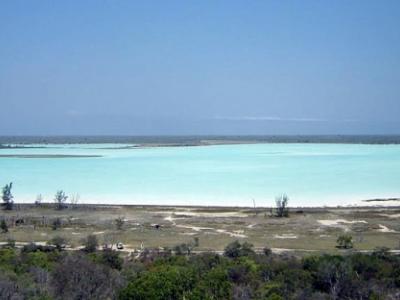
Tsimanampetsotsa National Park, named after its spectacular lake and main park highlight, is located in the southwest of Madagascar, not far from the coast and approximately 90km south of Tulear and comprises 430 km2 of spiny forest and wetlands.
This area was already protected in 1927 due to its biological meaning (90% of the flora and fauna is endemic!) mainly as habitat for water birds, and became a National Park in 1966. These water supplies are basic both for humans and for animals and plants, since Tsimanampetsotsa (which means “lake without dolphins” in Malagasy) lies in the most arid zone of the island, which receives only around 300 mm rain each year.
Apart from the lake itself, there are two main landscapes inside the park:
- a calcareous plateau covered with dense xerophilous thickets (a locally endemic spiny forest), huge baobabs and banyan trees
- the sand dunes along the coast covered by a grassy blanket.
The park also has numerous caves and sinkholes, which are the result of an underground stream.
Tsimanampetsotsa is a birders paradise. More than 100 species are found here, including pink, greater and dwarf flamingos forming big colonies on the lake, 5 Coua species, Archbold´s newtonia, Madagascar Plover, red-shouldered vanga or Lafresnaye´s vanga.
Apart from birds, there are 12 species of mammals, among them the extremely rare and local endemic Grandidier´s mongoose and 4 lemur species: ring-tailed lemur, Verreaux´s sifaka, Gray-brown mouse lemur and white-footed sportive lemur.
Among the 39 reptile species, the most significant one is the radiated turtle, which is endemic to this region and extremely endangered to extinction.
Because of the chemical composition of the saline lake, no fish can survive in it. Nevertheless, the unique blind fish of the world is easy to find in some underground caves.
There are several easy circuits designed to suit all fit conditions and personal interests:
Tsiamaso circuit: this is the cave circuit where you can admire the stalactites and stalagmites and observe the famous blind fishes.
Andaka circuit: a short walk along the lake shore special for flamingo lovers. You will enjoy beautiful views and get to see many other birds and plants.
Emande circuit: you will visit old tombs and enjoy some terrific landscapes whilst trying to spot lemurs, reptiles and water birds.
Andalamaike circuit: a botanical walk through arid landscapes focused on baobabs, radiated turtles, land birds and the underground cave.
The best months to visit Tsimanampesotsa are between April and December since the lake is covered with the flamingo colonies.
Tsimanampesotsa National Park is accessible all the year round and is opened between 7 am and 5 pm every day.
It is strongly recommended to bring walking shoes, sun protection and plenty of drinking water!
From Tulear take the road along the coast southwards passing through Anakao until the town of Beheloka. From here continue along a sandy poor path about 1-2 hours until Efoetse, where the main entrance is situated.
It is also possible to reach the Park by boar from Anakao. The journey takes around 4 hours depending on the type of boat available.
There is no public transport heading to the park, so visitors will need their own car or arrange a day trip from a hotel in Anakao or Beheloka.
